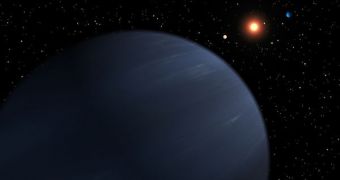Astronomers announce the discovery of a new exoplanet, which appears to be one of the smallest such celestial objects ever identified. According to experts, it is only four times larger than the Earth, which makes it the second smallest exoplanet in the known Universe. For the new discovery, a research group used the twin Keck Telescopes in Hawaii, which function as a single observatory, via interferometry. Details of the findings were presented yesterday in Washington DC, at the 215th meeting of the American Astronomical Society (AAS), Space reports.
The newly discovered body has been cataloged as a Super-Earth, a type of planet that is only several times larger than our own corner of the Universe. Only a select few of the over 400 exoplanets thus far discovered are a part of this category, and the main strive in this line of research at this time is to find more. Telescopes as the recently launched Kepler and the planned JWST are, or will be, used to scan the skies in search of Earth-sized planets. These bodies are the most suited for supporting life, astronomers and planetary scientists believe.
“This is quite a remarkable discovery. It shows that we can push down and find smaller and smaller planets,” University of California in Berkeley (UCB) astronomer Andrew Howard, who presented the findings at the conference, said. As is the custom for astronomers, they gave the new planet a very catchy name, HD156668b. It lies relatively nearby, just 80 light-years away, in the constellation Hercules. According to early measurements, it appears to be orbiting its parent star about once every four days or so. Also involved in the research were experts from the California Institute of Technology (Caltech), in Pasadena, the Yale University, and the Pennsylvania State University (Penn State).
The exoplanet was discovered by analyzing its parent star's wobble. This is a phenomenon that occurs when a planet orbiting such a body pushes and pulls on it, causing the two to spin around a common center of gravity, which is not necessarily located at the core of the star. This translates into the star shifting its position slightly, or wobbling, in a way that can be recorded by the massively sophisticated telescopes we have at our disposal today.

 14 DAY TRIAL //
14 DAY TRIAL //